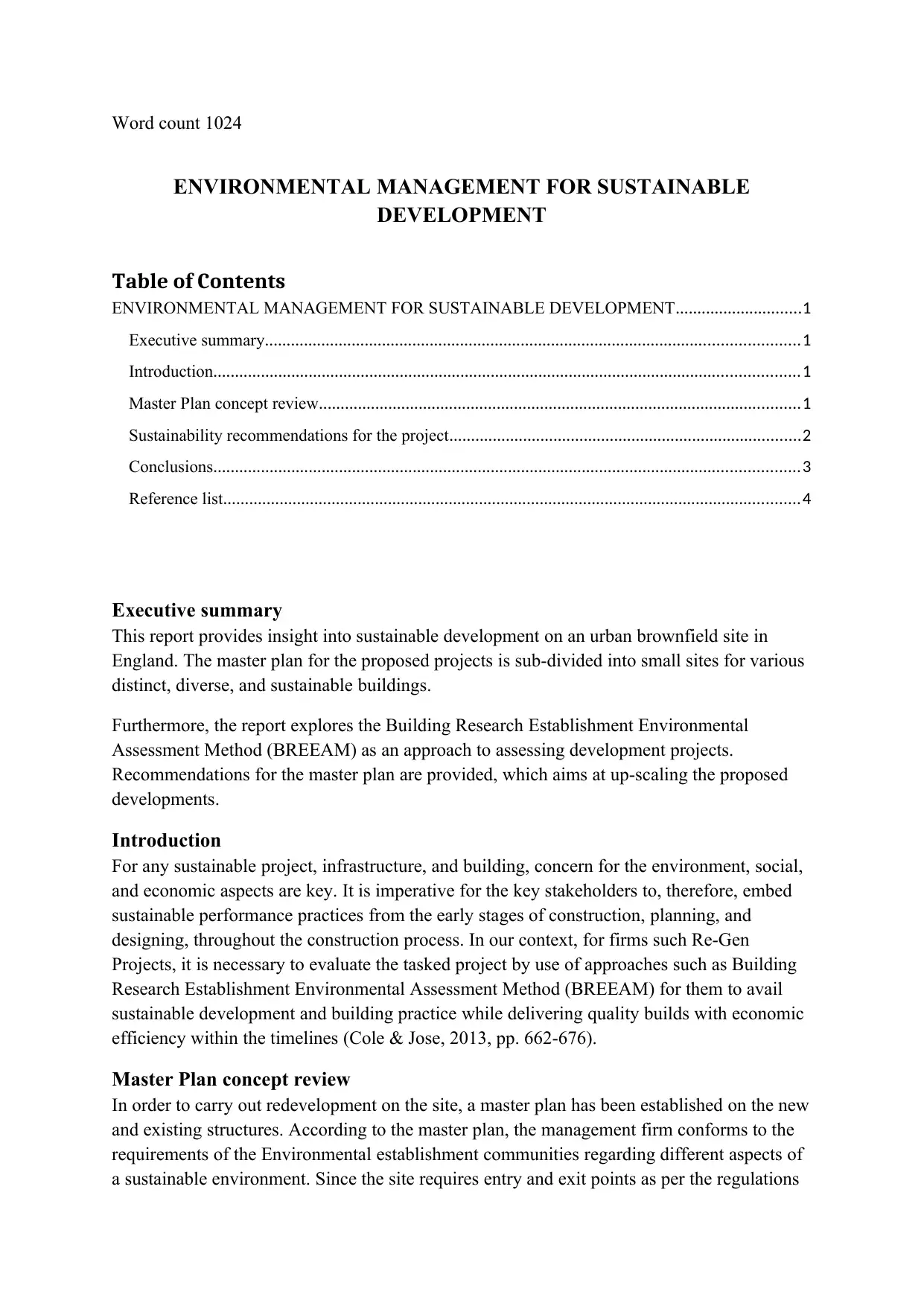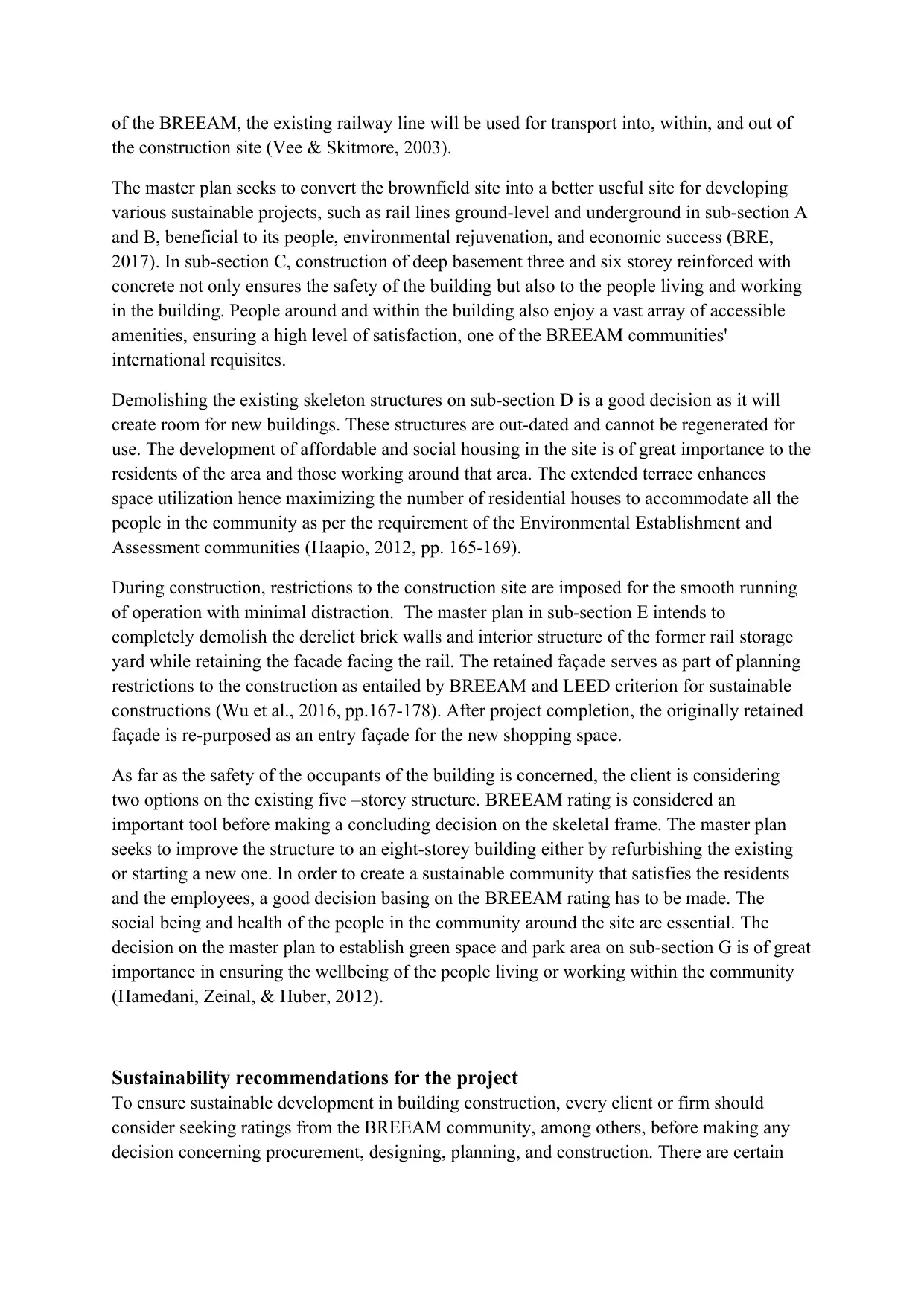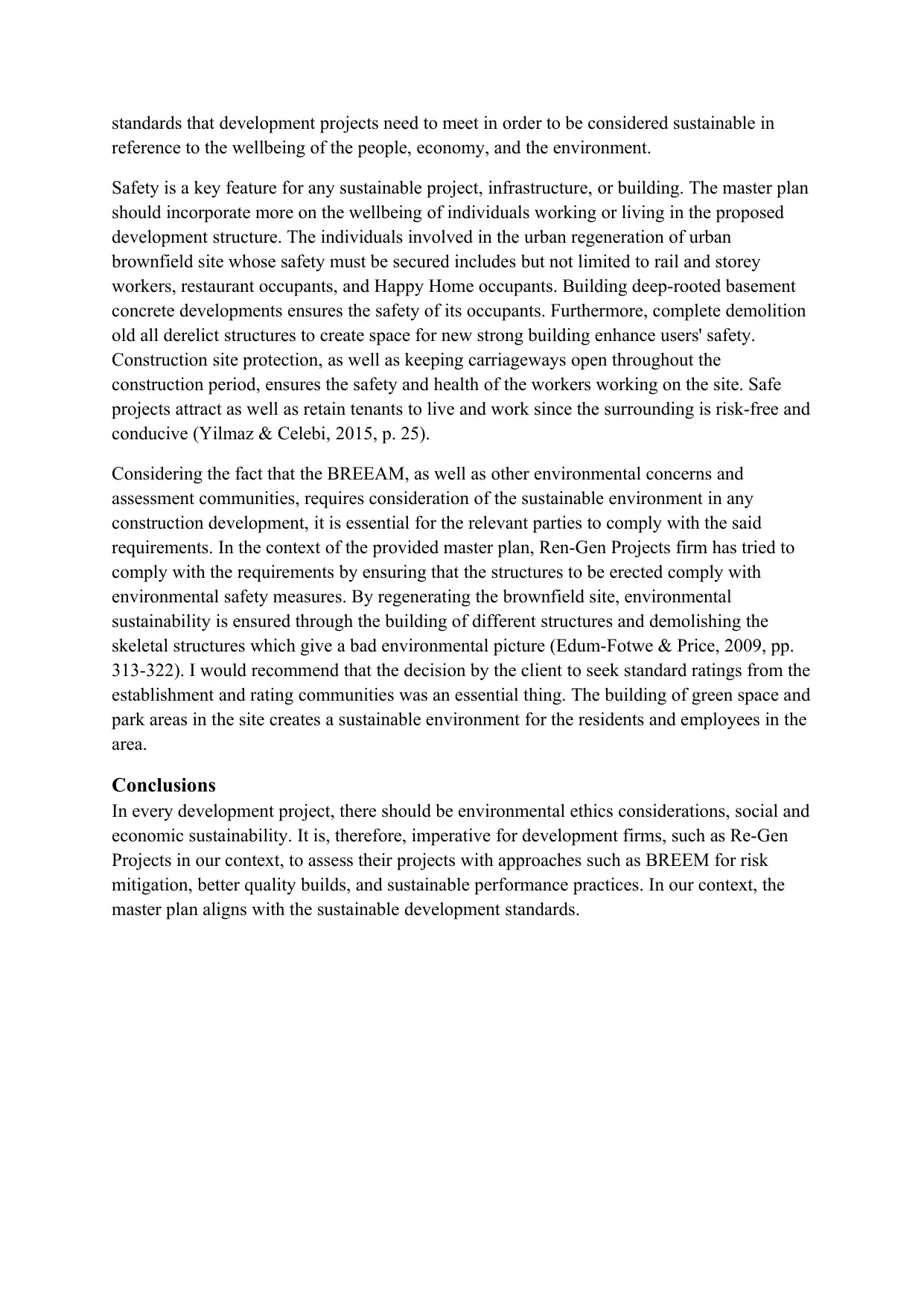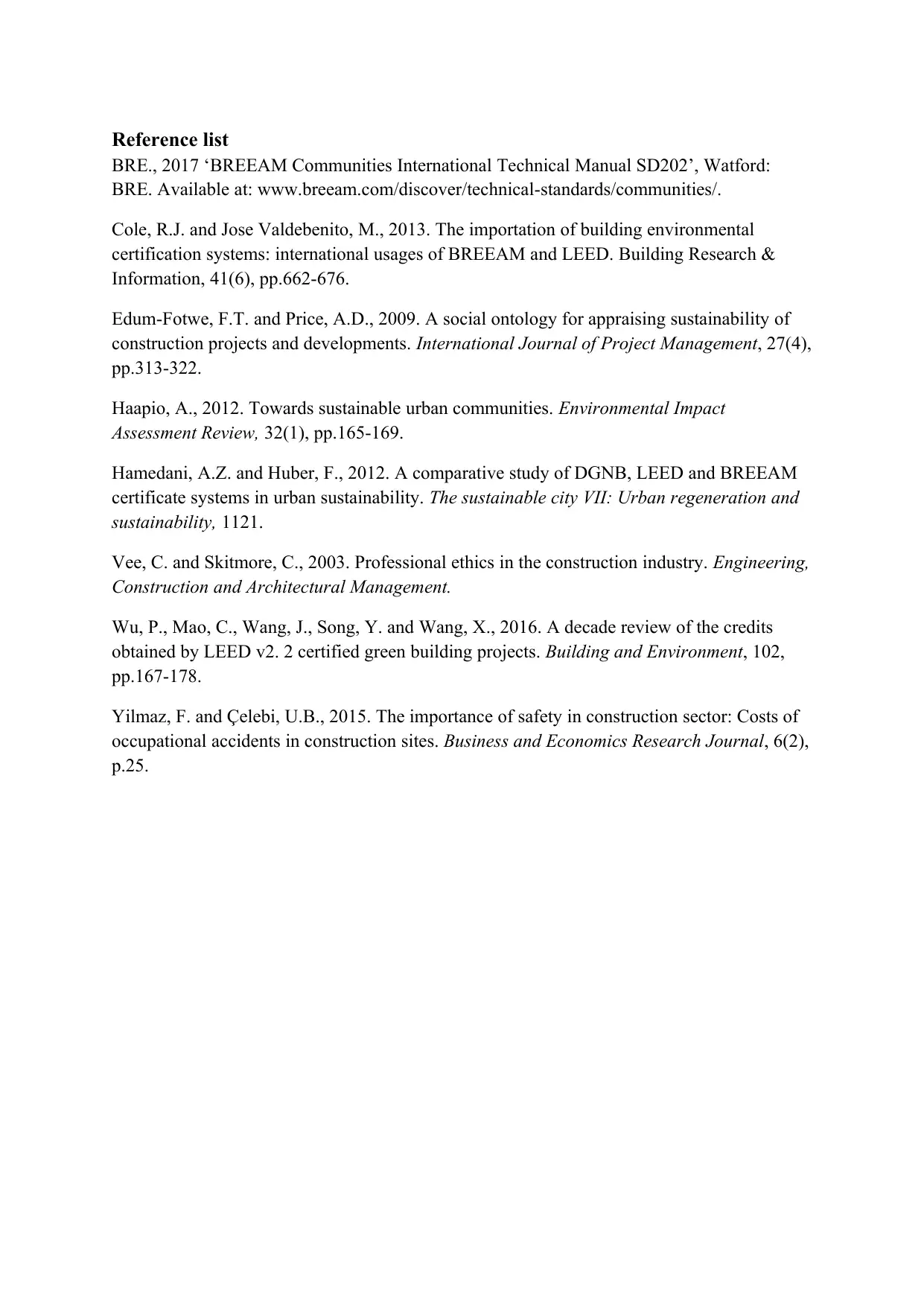Environmental Management for Sustainable Development: Project Report
VerifiedAdded on 2022/09/25
|4
|1544
|20
Report
AI Summary
This report provides an in-depth analysis of environmental management for a sustainable development project on an urban brownfield site in England. The report begins with an executive summary and an introduction that emphasizes the importance of integrating environmental, social, and economic considerations from the early stages of construction. The core of the report reviews the master plan concept, focusing on how the plan aligns with Building Research Establishment Environmental Assessment Method (BREEAM) standards. It details the proposed redevelopment, including the use of existing infrastructure like railway lines, the construction of various sustainable buildings, and the demolition of outdated structures. The report then offers specific sustainability recommendations, such as the need for BREEAM ratings and the incorporation of safety measures. Finally, the report concludes by reiterating the importance of environmental ethics and sustainable practices in development projects, emphasizing the role of assessments like BREEAM to ensure quality builds and sustainable performance. The report is a valuable resource for students studying environmental engineering and sustainable development.

Word count 1024
ENVIRONMENTAL MANAGEMENT FOR SUSTAINABLE
DEVELOPMENT
Table of Contents
ENVIRONMENTAL MANAGEMENT FOR SUSTAINABLE DEVELOPMENT.............................1
Executive summary...........................................................................................................................1
Introduction.......................................................................................................................................1
Master Plan concept review...............................................................................................................1
Sustainability recommendations for the project.................................................................................2
Conclusions.......................................................................................................................................3
Reference list.....................................................................................................................................4
Executive summary
This report provides insight into sustainable development on an urban brownfield site in
England. The master plan for the proposed projects is sub-divided into small sites for various
distinct, diverse, and sustainable buildings.
Furthermore, the report explores the Building Research Establishment Environmental
Assessment Method (BREEAM) as an approach to assessing development projects.
Recommendations for the master plan are provided, which aims at up-scaling the proposed
developments.
Introduction
For any sustainable project, infrastructure, and building, concern for the environment, social,
and economic aspects are key. It is imperative for the key stakeholders to, therefore, embed
sustainable performance practices from the early stages of construction, planning, and
designing, throughout the construction process. In our context, for firms such Re-Gen
Projects, it is necessary to evaluate the tasked project by use of approaches such as Building
Research Establishment Environmental Assessment Method (BREEAM) for them to avail
sustainable development and building practice while delivering quality builds with economic
efficiency within the timelines (Cole & Jose, 2013, pp. 662-676).
Master Plan concept review
In order to carry out redevelopment on the site, a master plan has been established on the new
and existing structures. According to the master plan, the management firm conforms to the
requirements of the Environmental establishment communities regarding different aspects of
a sustainable environment. Since the site requires entry and exit points as per the regulations
ENVIRONMENTAL MANAGEMENT FOR SUSTAINABLE
DEVELOPMENT
Table of Contents
ENVIRONMENTAL MANAGEMENT FOR SUSTAINABLE DEVELOPMENT.............................1
Executive summary...........................................................................................................................1
Introduction.......................................................................................................................................1
Master Plan concept review...............................................................................................................1
Sustainability recommendations for the project.................................................................................2
Conclusions.......................................................................................................................................3
Reference list.....................................................................................................................................4
Executive summary
This report provides insight into sustainable development on an urban brownfield site in
England. The master plan for the proposed projects is sub-divided into small sites for various
distinct, diverse, and sustainable buildings.
Furthermore, the report explores the Building Research Establishment Environmental
Assessment Method (BREEAM) as an approach to assessing development projects.
Recommendations for the master plan are provided, which aims at up-scaling the proposed
developments.
Introduction
For any sustainable project, infrastructure, and building, concern for the environment, social,
and economic aspects are key. It is imperative for the key stakeholders to, therefore, embed
sustainable performance practices from the early stages of construction, planning, and
designing, throughout the construction process. In our context, for firms such Re-Gen
Projects, it is necessary to evaluate the tasked project by use of approaches such as Building
Research Establishment Environmental Assessment Method (BREEAM) for them to avail
sustainable development and building practice while delivering quality builds with economic
efficiency within the timelines (Cole & Jose, 2013, pp. 662-676).
Master Plan concept review
In order to carry out redevelopment on the site, a master plan has been established on the new
and existing structures. According to the master plan, the management firm conforms to the
requirements of the Environmental establishment communities regarding different aspects of
a sustainable environment. Since the site requires entry and exit points as per the regulations
Paraphrase This Document
Need a fresh take? Get an instant paraphrase of this document with our AI Paraphraser

of the BREEAM, the existing railway line will be used for transport into, within, and out of
the construction site (Vee & Skitmore, 2003).
The master plan seeks to convert the brownfield site into a better useful site for developing
various sustainable projects, such as rail lines ground-level and underground in sub-section A
and B, beneficial to its people, environmental rejuvenation, and economic success (BRE,
2017). In sub-section C, construction of deep basement three and six storey reinforced with
concrete not only ensures the safety of the building but also to the people living and working
in the building. People around and within the building also enjoy a vast array of accessible
amenities, ensuring a high level of satisfaction, one of the BREEAM communities'
international requisites.
Demolishing the existing skeleton structures on sub-section D is a good decision as it will
create room for new buildings. These structures are out-dated and cannot be regenerated for
use. The development of affordable and social housing in the site is of great importance to the
residents of the area and those working around that area. The extended terrace enhances
space utilization hence maximizing the number of residential houses to accommodate all the
people in the community as per the requirement of the Environmental Establishment and
Assessment communities (Haapio, 2012, pp. 165-169).
During construction, restrictions to the construction site are imposed for the smooth running
of operation with minimal distraction. The master plan in sub-section E intends to
completely demolish the derelict brick walls and interior structure of the former rail storage
yard while retaining the facade facing the rail. The retained façade serves as part of planning
restrictions to the construction as entailed by BREEAM and LEED criterion for sustainable
constructions (Wu et al., 2016, pp.167-178). After project completion, the originally retained
façade is re-purposed as an entry façade for the new shopping space.
As far as the safety of the occupants of the building is concerned, the client is considering
two options on the existing five –storey structure. BREEAM rating is considered an
important tool before making a concluding decision on the skeletal frame. The master plan
seeks to improve the structure to an eight-storey building either by refurbishing the existing
or starting a new one. In order to create a sustainable community that satisfies the residents
and the employees, a good decision basing on the BREEAM rating has to be made. The
social being and health of the people in the community around the site are essential. The
decision on the master plan to establish green space and park area on sub-section G is of great
importance in ensuring the wellbeing of the people living or working within the community
(Hamedani, Zeinal, & Huber, 2012).
Sustainability recommendations for the project
To ensure sustainable development in building construction, every client or firm should
consider seeking ratings from the BREEAM community, among others, before making any
decision concerning procurement, designing, planning, and construction. There are certain
the construction site (Vee & Skitmore, 2003).
The master plan seeks to convert the brownfield site into a better useful site for developing
various sustainable projects, such as rail lines ground-level and underground in sub-section A
and B, beneficial to its people, environmental rejuvenation, and economic success (BRE,
2017). In sub-section C, construction of deep basement three and six storey reinforced with
concrete not only ensures the safety of the building but also to the people living and working
in the building. People around and within the building also enjoy a vast array of accessible
amenities, ensuring a high level of satisfaction, one of the BREEAM communities'
international requisites.
Demolishing the existing skeleton structures on sub-section D is a good decision as it will
create room for new buildings. These structures are out-dated and cannot be regenerated for
use. The development of affordable and social housing in the site is of great importance to the
residents of the area and those working around that area. The extended terrace enhances
space utilization hence maximizing the number of residential houses to accommodate all the
people in the community as per the requirement of the Environmental Establishment and
Assessment communities (Haapio, 2012, pp. 165-169).
During construction, restrictions to the construction site are imposed for the smooth running
of operation with minimal distraction. The master plan in sub-section E intends to
completely demolish the derelict brick walls and interior structure of the former rail storage
yard while retaining the facade facing the rail. The retained façade serves as part of planning
restrictions to the construction as entailed by BREEAM and LEED criterion for sustainable
constructions (Wu et al., 2016, pp.167-178). After project completion, the originally retained
façade is re-purposed as an entry façade for the new shopping space.
As far as the safety of the occupants of the building is concerned, the client is considering
two options on the existing five –storey structure. BREEAM rating is considered an
important tool before making a concluding decision on the skeletal frame. The master plan
seeks to improve the structure to an eight-storey building either by refurbishing the existing
or starting a new one. In order to create a sustainable community that satisfies the residents
and the employees, a good decision basing on the BREEAM rating has to be made. The
social being and health of the people in the community around the site are essential. The
decision on the master plan to establish green space and park area on sub-section G is of great
importance in ensuring the wellbeing of the people living or working within the community
(Hamedani, Zeinal, & Huber, 2012).
Sustainability recommendations for the project
To ensure sustainable development in building construction, every client or firm should
consider seeking ratings from the BREEAM community, among others, before making any
decision concerning procurement, designing, planning, and construction. There are certain

standards that development projects need to meet in order to be considered sustainable in
reference to the wellbeing of the people, economy, and the environment.
Safety is a key feature for any sustainable project, infrastructure, or building. The master plan
should incorporate more on the wellbeing of individuals working or living in the proposed
development structure. The individuals involved in the urban regeneration of urban
brownfield site whose safety must be secured includes but not limited to rail and storey
workers, restaurant occupants, and Happy Home occupants. Building deep-rooted basement
concrete developments ensures the safety of its occupants. Furthermore, complete demolition
old all derelict structures to create space for new strong building enhance users' safety.
Construction site protection, as well as keeping carriageways open throughout the
construction period, ensures the safety and health of the workers working on the site. Safe
projects attract as well as retain tenants to live and work since the surrounding is risk-free and
conducive (Yilmaz & Celebi, 2015, p. 25).
Considering the fact that the BREEAM, as well as other environmental concerns and
assessment communities, requires consideration of the sustainable environment in any
construction development, it is essential for the relevant parties to comply with the said
requirements. In the context of the provided master plan, Ren-Gen Projects firm has tried to
comply with the requirements by ensuring that the structures to be erected comply with
environmental safety measures. By regenerating the brownfield site, environmental
sustainability is ensured through the building of different structures and demolishing the
skeletal structures which give a bad environmental picture (Edum-Fotwe & Price, 2009, pp.
313-322). I would recommend that the decision by the client to seek standard ratings from the
establishment and rating communities was an essential thing. The building of green space and
park areas in the site creates a sustainable environment for the residents and employees in the
area.
Conclusions
In every development project, there should be environmental ethics considerations, social and
economic sustainability. It is, therefore, imperative for development firms, such as Re-Gen
Projects in our context, to assess their projects with approaches such as BREEM for risk
mitigation, better quality builds, and sustainable performance practices. In our context, the
master plan aligns with the sustainable development standards.
reference to the wellbeing of the people, economy, and the environment.
Safety is a key feature for any sustainable project, infrastructure, or building. The master plan
should incorporate more on the wellbeing of individuals working or living in the proposed
development structure. The individuals involved in the urban regeneration of urban
brownfield site whose safety must be secured includes but not limited to rail and storey
workers, restaurant occupants, and Happy Home occupants. Building deep-rooted basement
concrete developments ensures the safety of its occupants. Furthermore, complete demolition
old all derelict structures to create space for new strong building enhance users' safety.
Construction site protection, as well as keeping carriageways open throughout the
construction period, ensures the safety and health of the workers working on the site. Safe
projects attract as well as retain tenants to live and work since the surrounding is risk-free and
conducive (Yilmaz & Celebi, 2015, p. 25).
Considering the fact that the BREEAM, as well as other environmental concerns and
assessment communities, requires consideration of the sustainable environment in any
construction development, it is essential for the relevant parties to comply with the said
requirements. In the context of the provided master plan, Ren-Gen Projects firm has tried to
comply with the requirements by ensuring that the structures to be erected comply with
environmental safety measures. By regenerating the brownfield site, environmental
sustainability is ensured through the building of different structures and demolishing the
skeletal structures which give a bad environmental picture (Edum-Fotwe & Price, 2009, pp.
313-322). I would recommend that the decision by the client to seek standard ratings from the
establishment and rating communities was an essential thing. The building of green space and
park areas in the site creates a sustainable environment for the residents and employees in the
area.
Conclusions
In every development project, there should be environmental ethics considerations, social and
economic sustainability. It is, therefore, imperative for development firms, such as Re-Gen
Projects in our context, to assess their projects with approaches such as BREEM for risk
mitigation, better quality builds, and sustainable performance practices. In our context, the
master plan aligns with the sustainable development standards.
⊘ This is a preview!⊘
Do you want full access?
Subscribe today to unlock all pages.

Trusted by 1+ million students worldwide

Reference list
BRE., 2017 ‘BREEAM Communities International Technical Manual SD202’, Watford:
BRE. Available at: www.breeam.com/discover/technical-standards/communities/.
Cole, R.J. and Jose Valdebenito, M., 2013. The importation of building environmental
certification systems: international usages of BREEAM and LEED. Building Research &
Information, 41(6), pp.662-676.
Edum-Fotwe, F.T. and Price, A.D., 2009. A social ontology for appraising sustainability of
construction projects and developments. International Journal of Project Management, 27(4),
pp.313-322.
Haapio, A., 2012. Towards sustainable urban communities. Environmental Impact
Assessment Review, 32(1), pp.165-169.
Hamedani, A.Z. and Huber, F., 2012. A comparative study of DGNB, LEED and BREEAM
certificate systems in urban sustainability. The sustainable city VII: Urban regeneration and
sustainability, 1121.
Vee, C. and Skitmore, C., 2003. Professional ethics in the construction industry. Engineering,
Construction and Architectural Management.
Wu, P., Mao, C., Wang, J., Song, Y. and Wang, X., 2016. A decade review of the credits
obtained by LEED v2. 2 certified green building projects. Building and Environment, 102,
pp.167-178.
Yilmaz, F. and Çelebi, U.B., 2015. The importance of safety in construction sector: Costs of
occupational accidents in construction sites. Business and Economics Research Journal, 6(2),
p.25.
BRE., 2017 ‘BREEAM Communities International Technical Manual SD202’, Watford:
BRE. Available at: www.breeam.com/discover/technical-standards/communities/.
Cole, R.J. and Jose Valdebenito, M., 2013. The importation of building environmental
certification systems: international usages of BREEAM and LEED. Building Research &
Information, 41(6), pp.662-676.
Edum-Fotwe, F.T. and Price, A.D., 2009. A social ontology for appraising sustainability of
construction projects and developments. International Journal of Project Management, 27(4),
pp.313-322.
Haapio, A., 2012. Towards sustainable urban communities. Environmental Impact
Assessment Review, 32(1), pp.165-169.
Hamedani, A.Z. and Huber, F., 2012. A comparative study of DGNB, LEED and BREEAM
certificate systems in urban sustainability. The sustainable city VII: Urban regeneration and
sustainability, 1121.
Vee, C. and Skitmore, C., 2003. Professional ethics in the construction industry. Engineering,
Construction and Architectural Management.
Wu, P., Mao, C., Wang, J., Song, Y. and Wang, X., 2016. A decade review of the credits
obtained by LEED v2. 2 certified green building projects. Building and Environment, 102,
pp.167-178.
Yilmaz, F. and Çelebi, U.B., 2015. The importance of safety in construction sector: Costs of
occupational accidents in construction sites. Business and Economics Research Journal, 6(2),
p.25.
1 out of 4
Related Documents
Your All-in-One AI-Powered Toolkit for Academic Success.
+13062052269
info@desklib.com
Available 24*7 on WhatsApp / Email
![[object Object]](/_next/static/media/star-bottom.7253800d.svg)
Unlock your academic potential
Copyright © 2020–2025 A2Z Services. All Rights Reserved. Developed and managed by ZUCOL.





